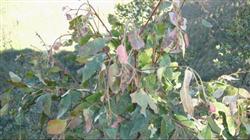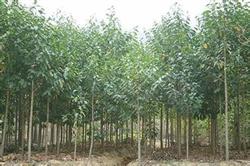Remedial measures for frozen eucalyptus trees

The main manifestation of freezing injury of eucalyptus is frozen tip, and severe aboveground parts freeze to death. The severity of freezing injury varies according to eucalyptus variety and forest age. Eucalyptus urophylla, Eucalyptus grandis and Eucalyptus Dunn are the more cold-tolerant species of Eucalyptus, while Eucalyptus urophylla and Eucalyptus urophylla have poor cold tolerance. The main anti-freezing technical measures are as follows: 1. Slight frost injury (the top is frozen): it will not have much effect on the growth of the following year, as long as it is managed according to the routine and pay attention to keep the top strong lateral buds. 2. Moderate freezing injury (1 stroke 2 or more): regardless of age, it is best to cut off the stem at a distance of 10 to 15 cm from the ground to promote its germination and renewal. 3. Severe freezing injury (the aboveground part or even the root system is frozen): truncating and sprouting, or replenishing seedlings with container seedlings, and replanting cold-tolerant eucalyptus varieties or other tree species. (1) Technical methods of freezing injury investigation reference standard for evaluation of frost injury grade of eucalyptus: survey was conducted according to typical sampling methods, and then statistics were made on the frost injury of eucalyptus species and clones. Grade 0: there is basically no frost injury, and the tender and slightly wilted young leaves suffer frost injury and can grow normally. Ⅰ grade: the main stem is frozen and withered less than 50cm, some branches are damaged by freezing, most of the leaf tips are frozen and withered, and the death rate of the whole leaf is less than 30%. Ⅱ grade: main stem freeze-withered 1pm less than 3, 1-year-old branches withered less than 1pm, leaf withered rate less than 70%. Ⅲ grade: main stem freeze-dry 1pm 1pm 2, 1-year-old branches withered, 2-year-old branches freeze-damaged, leaves withered, can resume growth. Ⅳ class: main stem freeze-dry 1-pound 2-pound 3, 1-year-old branches withered, 2-year-old branches withered 60%, crown withered, it is difficult to restore growth. Ⅴ: all the aboveground parts were frozen and withered, only the base of the trunk was not damaged. (2) Technical measures for emergency rejuvenation: 1. To cut off or remove the frozen dead part of the plant. Eucalyptus usually does not appear the symptom of freezing to death immediately after freezing injury, so the freeze-dried parts of Ⅱ and Ⅲ eucalyptus should be cut off so that they can sprout and grow normally again. For freeze-damaged Ⅳ eucalyptus, cut dry at a distance of 10-15 cm from the ground to promote its germination and regeneration. For Ⅴ grade eucalyptus suffering from freezing injury, stem cutting and sprouting renewal can be carried out, or container seedlings can be used to replace cold-tolerant eucalyptus varieties or other tree species. For slight freezing injury (Ⅰ grade), it will not have much effect on the growth of the following year, as long as it is managed according to the routine and pay attention to keep the top strong lateral buds. 2. Strengthen the management of tending. When the sprout strip grows to about 40 cm, keep 1-2 strong sprout strips, loosen the soil, apply calcium magnesium phosphate fertilizer with boron or special fertilizer for eucalyptus, and pay attention to observation and control of diseases and insect pests.
- Prev

Introduction to the skills of topdressing in the growth process of Eucalyptus
Eucalyptus red leaf blight is a physiological disease, which is mainly caused by the serious lack of B, one of the trace elements necessary for normal plant growth and seed setting. Etiology: B affects carbohydrate synthesis and transport, cell division, cell maturation, cell wall and pollen tube formation in the process of plant growth and flowering.
- Next

Planting techniques of Eucalyptus
Eucalyptus belongs to Myrtaceae, Eucalyptus [EucalytusSPP.] The general name of tree species is not only one of the three famous fast-growing tree species in the world, but also one of the most valuable hardwood of broad-leaved trees in the world. Native to Australia, as many as 945 tree species, large distribution span, performance differences, in the world 10.
Related
- Fuxing push coffee new agricultural production and marketing class: lack of small-scale processing plants
- Jujube rice field leisure farm deep ploughing Yilan for five years to create a space for organic food and play
- Nongyu Farm-A trial of organic papaya for brave women with advanced technology
- Four points for attention in the prevention and control of diseases and insect pests of edible fungi
- How to add nutrient solution to Edible Fungi
- Is there any good way to control edible fungus mites?
- Open Inoculation Technology of Edible Fungi
- Is there any clever way to use fertilizer for edible fungus in winter?
- What agents are used to kill the pathogens of edible fungi in the mushroom shed?
- Rapid drying of Edible Fungi

